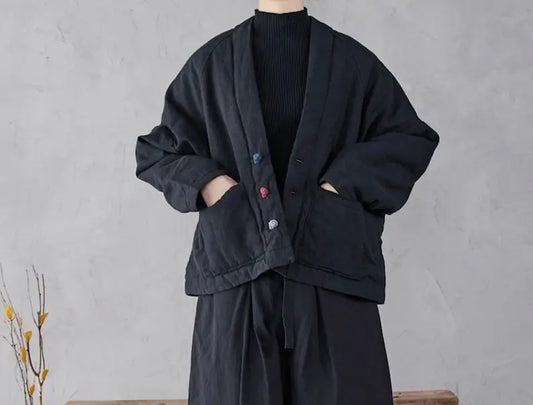Women's Hanten - An Emblem of Cultural Heritage
The intricate tapestry of Japanese sartorial culture is replete with garments that are not just aesthetically pleasing but also infused with historical and societal significance. Among these garments, the Hanten stands out, especially the Women's Hanten, which has evolved over centuries to fit the requirements of Japanese women from different walks of life. This essay delves into the origins, evolution, and cultural significance of Women's Hanten.The Hanten, which originated during the Edo period (1603–1868), is a traditional Japanese short coat, reminiscent of the Haori but distinguishable by its padded nature, meant for warmth. The need for such a garment emerged from the cold winters of Japan, where a functional yet traditionally acceptable piece of clothing was necessary. While the earliest Hanten were mainly for men, the garment gradually made its way into women's wardrobes, reflecting the broader changes in Japanese society where women began to occupy more public spaces.
The Women's Hanten is often made of cotton, but silk variations can be found for more formal occasions. The coat's padding provides insulation, making it ideal for the colder months. It is characterized by straight sleeves, and its length varies but usually stops at the hip or mid-thigh. The design of the Hanten is relatively simple, often adorned with sashiko stitching, which is not just decorative but also strengthens and reinforces the fabric.
Patterns and motifs on Women's Hanten vary. Some come with family crests or mon, while others have picturesque scenes from nature, folk tales, or everyday life. These designs, like many Japanese garments, are rooted in symbolism, each telling a story or conveying a message.
Beyond its obvious functionality, the Hanten, especially the Women's variant, carries cultural significance. First and foremost, it is a testament to Japanese ingenuity in textile design, combining utility with aesthetics. It demonstrates the Japanese principle of 'Mottainai,' which can be translated as a sense of regret concerning waste. The sashiko stitching, for instance, originated as a way to mend and reinforce worn-out clothes, thus giving them a longer life.
In a broader sense, Women's Hanten, like many traditional garments, became an emblem of identity. It expressed regional differences, family affiliations, and even individual personalities. As women donned these garments, it symbolized their connection to their roots, their communities, and their own unique place within that tapestry.
The global fashion scene today is experiencing a revival of traditional garments, as modern consumers seek authenticity, sustainability, and a connection to heritage. Women's Hanten, in this context, has found its space. Contemporary designers are incorporating Hanten-inspired elements into their collections, and urban Japanese women are donning Hanten with modern outfits, fusing tradition with the contemporary.







